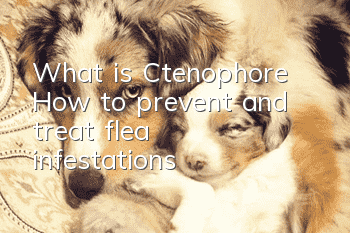What is Ctenophore? How to prevent and treat flea infestations

Ctenophore
The main fleas that infest dogs and cats are canine ctenophores and cat flea. They cause dermatitis in dogs and cats and are also transmitters of the tapeworm Diplopore canis. Ctenophylla felis mainly infects cats and dogs, while Ctenophyllus canis is restricted to dogs and wild canids. The individual size of ctenophora fleas varies greatly. Female fleas are long, sometimes more than 2.5mm, and male fleas are less than 1mm. Fleas are small, brown, narrow-sided insects that can be found when moving on the body surface. The eggs are white, small, and spherical.
Fleas lay eggs on the dog's coat. The eggs fall off the coat and hatch in 2 to 4 days under suitable environmental conditions. There are three types of larvae. First and second instar larvae feed on plant and animal matter (including the excrement of adult fleas). The third instar larvae only make cocoons and do not eat. The cocoon is oval and difficult to detect. It is usually attached to the dog's bedding and pupates after a few days. The total process takes about two weeks to develop from an egg to an adult flea. Temperature and humidity have a great impact on fleas. Under low temperature and high humidity conditions, fleas can survive for more than a year without eating. However, under high temperature (dry) and low humidity conditions, fleas die after a few days. Dogs and cats become infected through direct contact or entering an area where adult fleas are present.
Prevention and treatment methods:
In the past, flea infections were often treated by wearing a dog collar (the main ingredient is one of synergistic pyrethroids, pyrethroids, carbamates, organic phosphates, etc.). This method is simple, reliable, and effective. It lasts for 2 to 4 months, but has a pungent smell.
The current effective treatment method is to use "Fulaien". "Big Pet" (can be used for Collies) drops or sprays are safe, efficient, and low in toxicity. They are the first choice drugs for preventing and treating fleas in the world today. There are also oral drugs to kill fleas clinically. Use shampoo to wash your dog On the coat, fleas can be washed off or killed, but there is no lasting effect, so shampoo alone cannot control flea infection. Use medicated powder (such as "Bixilin", etc.) and sprinkle it into the coat, and then smooth the hair. Smooth out the hair. Medicated baths are also an effective method that can last for a week and are used by many dog owners. Oral flea-killing agents can kill fleas. This kind of medicine is mainly some organophosphate compounds and is not used much now.< /p>
- Dogs can’t just chew bones if they want to, just look at the consequences!
- Dogs being so indulgent are sick and need to be cured!
- Is it good for dogs to wear shoes? What are the pros and cons?
- Will dogs die if they eat chili peppers?
- What should I do if my border collie doesn’t eat?
- Do dogs need to eat vegetables?
- How to choose poodle dog food and what to pay attention to when buying dog food
- How to tell the difference between a Silver Fox and a Samoyed
- Daily care for golden retrievers
- How to train a German Shepherd at three months? The best time to train a German Shepherd!



